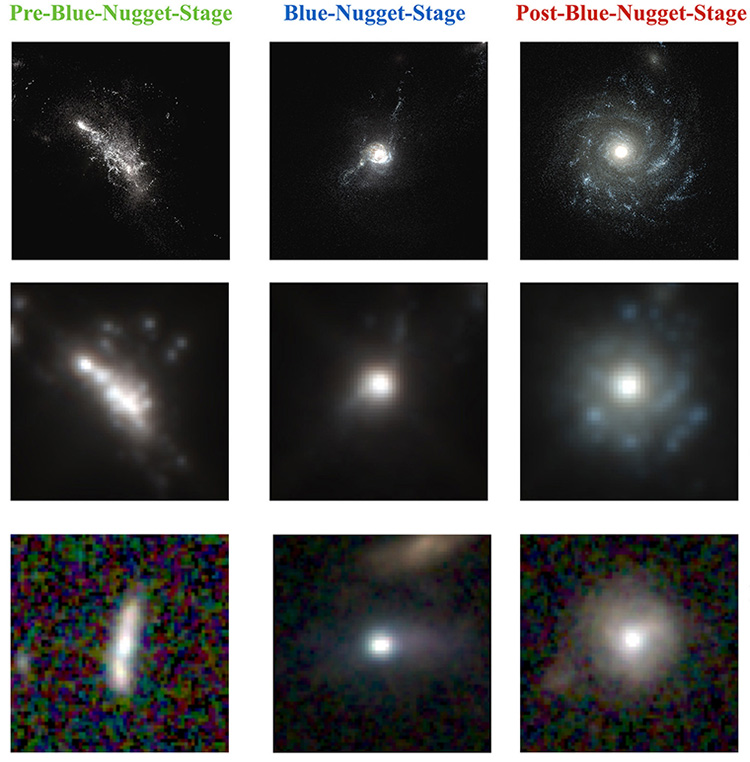
Deep learning is a subset of machine learning in Artificial Intelligence (AI) that has networks which are capable of learning unsupervised from data that is unstructured or unlabeled. Image and caption via Quora.
We published a story in April about an art historian using an innovative analysis technique to unlock architectural secrets. He was using a machine learning method called deep learning – which is used in, for example, facial recognition and speech recognition software – to do science. Similarly, astronomers are beginning to report the use of machine deep learning techniques to perform research that humans can’t do using more traditional methods.
Below we describe two recent examples: the first related to planets orbiting two stars, and the second related to classifying galaxies.
Artist’s impression of Kepler-16b, discovered by NASA’s Kepler mission and the first confirmed circumbinary planet. It is a gas giant that orbits close to the edge of its binary system’s habitable zone. Image via T. Pyle / NASA / JPL-Caltech/ RAS.
First, planets orbiting two stars. Can computers predict whether planets orbiting binary stars remain in stable orbits? That’s an important question because many (perhaps most) stars in our Milky Way galaxy appear to be in multiple star systems, and because planets in stable orbits might be expected to be the most habitable planets.
And, it turns out, the answer is yes. Researchers reported on April 23, 2018 that computers that undergo deep learning can make this prediction more successfully than human astronomers. A study on this subject looked at what many astronomers call Tatooines, planets orbiting two stars, named for the fictional Tatooine first introduced in 1977 as Luke Skywalker’s home in the original Star Wars movie. Researchers Chris Lam and David Kipping were both, at the time, at the Cool Worlds lab at Columbia University in New York (Lam has since obtained his PhD and moved on). Their study is published in the peer-reviewed journal Monthly Notices of the Royal Astronomical Society. The authors explained in a statement:
Tens of these planets have so far been discovered, but working out whether they may be habitable or not can be difficult.
Moving around two stars instead of just one can lead to large changes in a planet’s orbit, which mean that it is often either ejected from the system entirely, or it crashes violently into one of its twin stars. Traditional approaches to calculating which of these occurs for a given planet get significantly more complicated as soon as the extra star is thrown into the mix.
These researchers simulated millions of possible planets with different orbits using traditional methods and found that planets were being predicted as stable that were clearly not, and vice versa. Their new study showed how machine learning could make accurate predictions possible, even if the standard approach – based on Newton’s laws of gravity and motion – breaks down. They said:
After creating ten million hypothetical Tatooines with different orbits, and simulating each one to test for stability, this huge training set was fed into the deep learning network. Within just a few hours, the network was able to out-perform the accuracy of the standard approach.
Read more about this study via the RAS
In the video below from Cool Worlds Lab, David Kipping explains why three-body systems are so tricky and how deep learning analysis methods can save the day. It’s called Droids [Machines] Ponder Tatooine:
Second, classifying galaxies. Also on April 23, 2018, astronomers at UC Santa Cruz reported using machine deep learning techniques to help astronomers analyze images of galaxies and understand how galaxies form and evolve. This new study has been accepted for publication in the peer-reviewed Astrophysical Journal and is available online. In the study, researchers used computer simulations of galaxy formation to train a deep learning algorithm, which then:
… proved surprisingly good at analyzing images of galaxies from the Hubble Space Telescope.
The researchers said they used output from the simulations to generate mock images of simulated galaxies as they would look in ordinary Hubble observations. The mock images were used to train the deep learning system to recognize three key phases of galaxy evolution previously identified in the simulations. The researchers then gave the system a large set of actual Hubble images to classify.
The results showed a remarkable level of consistency, the astronomers said, in the classifications of simulated and real galaxies. Joel Primack of UC Santa Cruz said:
We were not expecting it to be all that successful. I’m amazed at how powerful this is. We know the simulations have limitations, so we don’t want to make too strong a claim. But we don’t think this is just a lucky fluke.
Read more about this study from UC Santa Cruz.

View larger. | Astronomers at UC Santa Cruz say a ‘deep learning’ algorithm trained on images from cosmological simulations is surprisingly successful at classifying real galaxies in Hubble images. Top row: High-resolution images from a computer simulation of a young galaxy going through three phases of evolution (before, during, and after the so-called “blue nugget” phase, a star-forming phase of galaxy evolution). Middle row: The same images from the computer simulation of a young galaxy in three phases of evolution as it would appear if observed by the Hubble Space Telescope. Bottom row: Hubble Space Telescope images of distant young galaxies classified by a deep learning algorithm trained to recognize the three phases of galaxy evolution. The width of each image is approximately 100,000 light-years. Images via UCSC.
Bottom line: Two recent examples of the use of machine deep learning in astronomy. The first is related to Tatooines, or planets orbiting two stars, and the second is related to classifying galaxies in Hubble Space Telescope images.
Source: A machine learns to predict the stability of circumbinary planets
from EarthSky https://ift.tt/2FUxHfj

Deep learning is a subset of machine learning in Artificial Intelligence (AI) that has networks which are capable of learning unsupervised from data that is unstructured or unlabeled. Image and caption via Quora.
We published a story in April about an art historian using an innovative analysis technique to unlock architectural secrets. He was using a machine learning method called deep learning – which is used in, for example, facial recognition and speech recognition software – to do science. Similarly, astronomers are beginning to report the use of machine deep learning techniques to perform research that humans can’t do using more traditional methods.
Below we describe two recent examples: the first related to planets orbiting two stars, and the second related to classifying galaxies.
Artist’s impression of Kepler-16b, discovered by NASA’s Kepler mission and the first confirmed circumbinary planet. It is a gas giant that orbits close to the edge of its binary system’s habitable zone. Image via T. Pyle / NASA / JPL-Caltech/ RAS.
First, planets orbiting two stars. Can computers predict whether planets orbiting binary stars remain in stable orbits? That’s an important question because many (perhaps most) stars in our Milky Way galaxy appear to be in multiple star systems, and because planets in stable orbits might be expected to be the most habitable planets.
And, it turns out, the answer is yes. Researchers reported on April 23, 2018 that computers that undergo deep learning can make this prediction more successfully than human astronomers. A study on this subject looked at what many astronomers call Tatooines, planets orbiting two stars, named for the fictional Tatooine first introduced in 1977 as Luke Skywalker’s home in the original Star Wars movie. Researchers Chris Lam and David Kipping were both, at the time, at the Cool Worlds lab at Columbia University in New York (Lam has since obtained his PhD and moved on). Their study is published in the peer-reviewed journal Monthly Notices of the Royal Astronomical Society. The authors explained in a statement:
Tens of these planets have so far been discovered, but working out whether they may be habitable or not can be difficult.
Moving around two stars instead of just one can lead to large changes in a planet’s orbit, which mean that it is often either ejected from the system entirely, or it crashes violently into one of its twin stars. Traditional approaches to calculating which of these occurs for a given planet get significantly more complicated as soon as the extra star is thrown into the mix.
These researchers simulated millions of possible planets with different orbits using traditional methods and found that planets were being predicted as stable that were clearly not, and vice versa. Their new study showed how machine learning could make accurate predictions possible, even if the standard approach – based on Newton’s laws of gravity and motion – breaks down. They said:
After creating ten million hypothetical Tatooines with different orbits, and simulating each one to test for stability, this huge training set was fed into the deep learning network. Within just a few hours, the network was able to out-perform the accuracy of the standard approach.
Read more about this study via the RAS
In the video below from Cool Worlds Lab, David Kipping explains why three-body systems are so tricky and how deep learning analysis methods can save the day. It’s called Droids [Machines] Ponder Tatooine:
Second, classifying galaxies. Also on April 23, 2018, astronomers at UC Santa Cruz reported using machine deep learning techniques to help astronomers analyze images of galaxies and understand how galaxies form and evolve. This new study has been accepted for publication in the peer-reviewed Astrophysical Journal and is available online. In the study, researchers used computer simulations of galaxy formation to train a deep learning algorithm, which then:
… proved surprisingly good at analyzing images of galaxies from the Hubble Space Telescope.
The researchers said they used output from the simulations to generate mock images of simulated galaxies as they would look in ordinary Hubble observations. The mock images were used to train the deep learning system to recognize three key phases of galaxy evolution previously identified in the simulations. The researchers then gave the system a large set of actual Hubble images to classify.
The results showed a remarkable level of consistency, the astronomers said, in the classifications of simulated and real galaxies. Joel Primack of UC Santa Cruz said:
We were not expecting it to be all that successful. I’m amazed at how powerful this is. We know the simulations have limitations, so we don’t want to make too strong a claim. But we don’t think this is just a lucky fluke.
Read more about this study from UC Santa Cruz.

View larger. | Astronomers at UC Santa Cruz say a ‘deep learning’ algorithm trained on images from cosmological simulations is surprisingly successful at classifying real galaxies in Hubble images. Top row: High-resolution images from a computer simulation of a young galaxy going through three phases of evolution (before, during, and after the so-called “blue nugget” phase, a star-forming phase of galaxy evolution). Middle row: The same images from the computer simulation of a young galaxy in three phases of evolution as it would appear if observed by the Hubble Space Telescope. Bottom row: Hubble Space Telescope images of distant young galaxies classified by a deep learning algorithm trained to recognize the three phases of galaxy evolution. The width of each image is approximately 100,000 light-years. Images via UCSC.
Bottom line: Two recent examples of the use of machine deep learning in astronomy. The first is related to Tatooines, or planets orbiting two stars, and the second is related to classifying galaxies in Hubble Space Telescope images.
Source: A machine learns to predict the stability of circumbinary planets
from EarthSky https://ift.tt/2FUxHfj

Aucun commentaire:
Enregistrer un commentaire